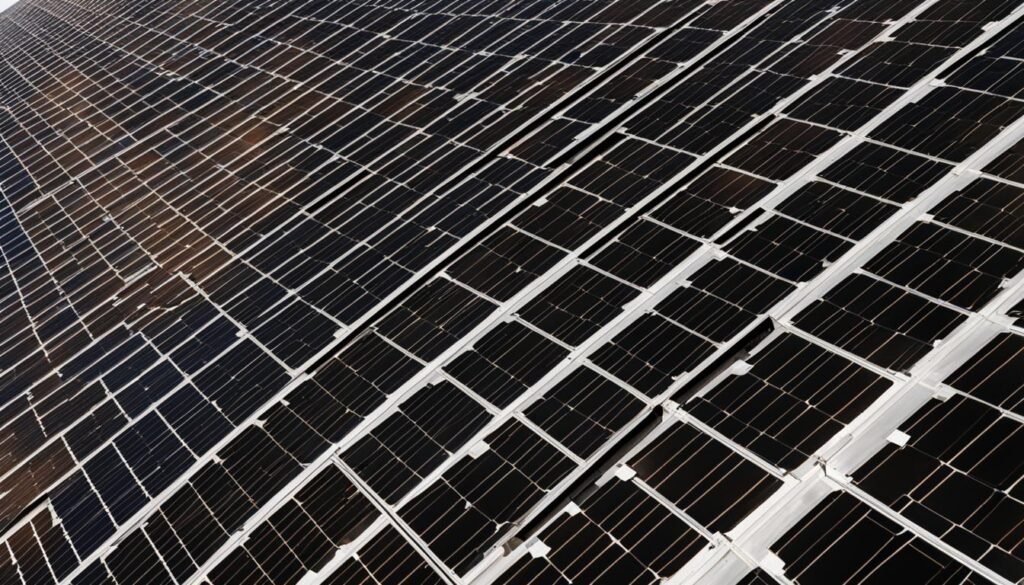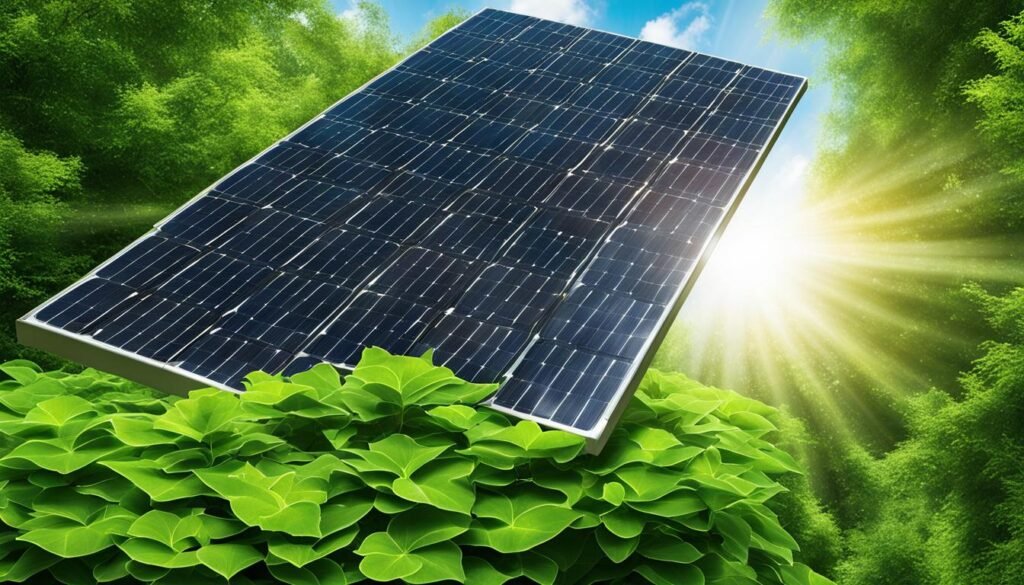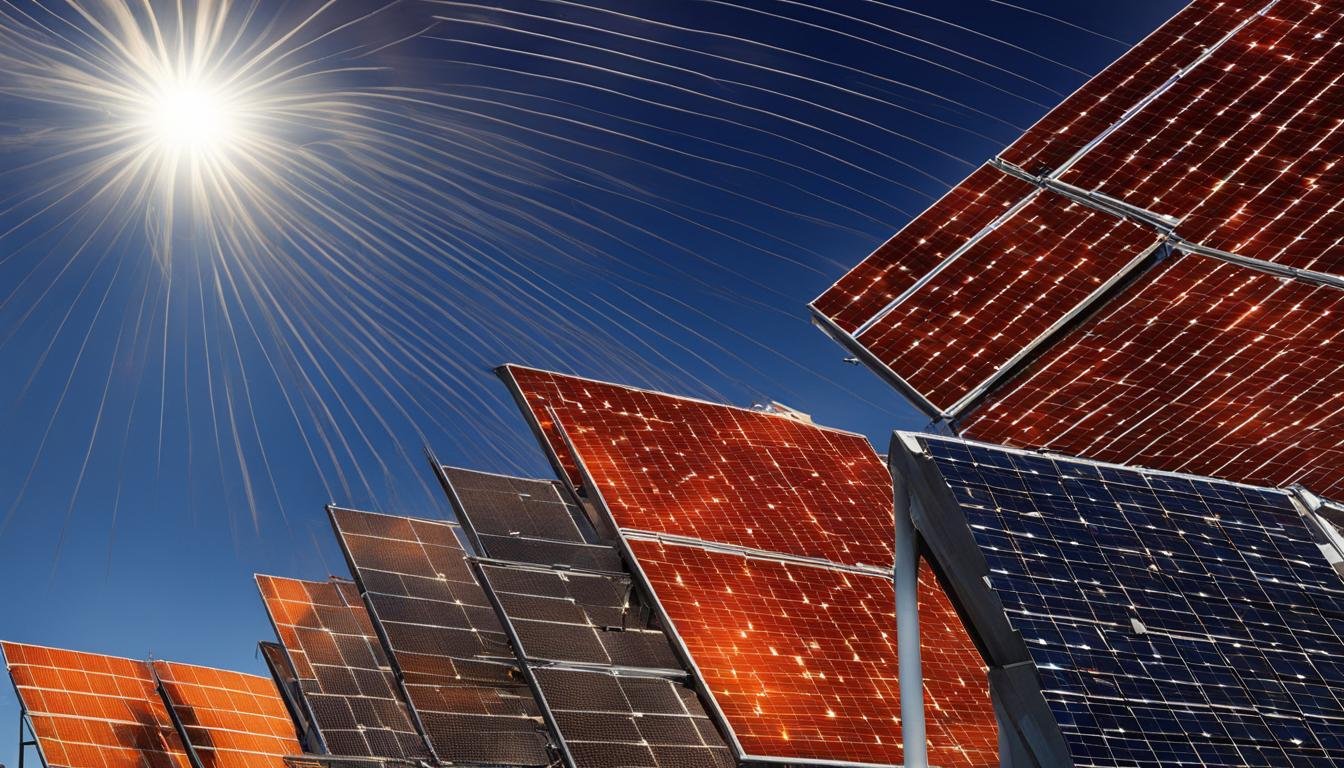Let me level with you – when it comes to solar panels, the big question on everyone’s lips is clear: how many kWh can a solar panel generate? Picture this: it’s 2023, and around us, roofs are blooming with glistening solar arrays, each panel a patch in a quilt of clean energy. With home solar panels cruising between 350 and 450 watts, I’m here to shed some light on just what that translates to in solar panel kWh output. It’s not just about giving life to your gadgets and banishing the darkness; it’s about savvy square footage use and smart electricity generation.
Strap in as I break down the science of solar panel electricity generation, and unpack the exact muscle of each panel soaking up the sun. Did you know that the power strutted out by SunPower’s 440-watt marvels, or the diligent offerings from Q CELLS and REC Group found on EnergySage, can tip the energy scales? Every beam of sunshine and every panel’s angle becomes critical in your personal electric symphony.
Key Takeaways
- Average home solar panel wattage stands firm in the 350 to 450 watts range.
- Efficiency is top-tier, with SunPower panels hitting a sweet 22.8% available via EnergySage.
- Knowing solar panel kWh output is pivotal for those playing the rooftop real estate game.
- Factor in sun exposure, roof orientation, and shading to get a true gauge of energy capacity.
- A solar squadron of 15-25 panels is typically needed to fully charge up a home’s power needs.
- How many kWh generated hinges on your solar setup’s location – the sunnier, the better.
Understanding Solar Panel Wattage and kWh Generation
Let’s shimmy into the sunlit world of solar wattage and unravel the mystery of calculating solar panel kWh. Imagine we’re in California, where the sun has a backstage pass and solar panels are the stars of the show. On the rooftops, 400-watt panels soak up the rays, each with the prowess to whip up about 600 kWh of energy per year, breaking down to a perky 1.6 kWh daily—enough to keep your mini-fridge humming with cold drinks.
Why just fantasize about individual panels when you can revel in the collective energy of your very own rooftop power plant? I’m talking about stringing together 25 of these solar dynamos to form a powerhouse that churns out no less than 15,000 kWh annually. That’s like running a small festival on your roof, year-round, without the noise complaints.
Now, efficiency is not just your middle name; it’s the key to making these solar panels sing. Think photovoltaic cell count, think light harnessing capabilities—yeah, these are the rock stars driving your solar panel’s ambition to reach its zenith in the realm of average solar panel energy production.
| Panel Wattage | Annual kWh Production | Efficiency |
|---|---|---|
| 350-watt | Approx. 525 kWh | Standard |
| 400-watt | Approx. 600 kWh | High |
| 450-watt | Approx. 675 kWh | Premium |
And just when you thought it couldn’t get any better, let’s not forget that these numbers aren’t set in stone. Every panel on your roof is like a gremlin that multiplies its efficiency when splashed with sunlight (minus the mischief). So grab yourself a solar panel kWh calculator, and let’s start crunching those numbers to see how your solar troops can best march toward energy independence.
Factors Affecting Solar Panel kWh Generation
Let me put on my solar detective hat and shine a light on the mystery of solar panel productivity. Every solar panel tells a story of kWh conquest, and the tale begins with location, efficiency, and a battle against temperature.
Impact of Panel Location and Sunlight Exposure
If solar panels had legs, they’d march to the sunniest spots on Earth. Alas, they rely on us to plant them where they can soak up the sun’s golden glory. The catch is, not all geographies are created equal. The Global Solar Atlas isn’t shy about that. You see, in the game of solar panel kWh generation, it’s the duration and quality of sunlight that hold the trump cards, and these are heavily influenced by our zip codes.
The Influence of Solar Panel Efficiency and Capacity
I’m here to tell you, friends, that in the world of solar energy, efficiency is king, and wattage capacity is its throne. Most home solar panels have an efficiency of about 20%, a decent figure by all accounts. Yet, like crafty conjurers, the top-tier solar panels from the likes of SunPower squeeze out efficiencies up to 22.8%—now that’s some magic I can get behind! Capacity, then, is the stage for this performance, typically between 1 kW and 4 kW for home setups.
Temperature Effects on Solar Energy Conversion
Oops! Did someone turn up the thermostat? We might love a warm day, but solar panels, not so much. Solar techs whisper tales of temperature coefficients, where a mere rise in heat could cause a solar panel’s wattage capacity to drop faster than my jaw at a magic show. But fear not, for even with a few efficiency percentage points lost, most inverters and batteries still operate with stellar efficiency over 95%. Indeed, they’re the unsung heroes of the solar energy conversion process.
Now let’s lay it all out on the table—the factors that make or break a solar panel’s kWh generation story. It’s more than just a numbers game; it’s a strategy forged by the elements themselves!
| Factor | Details | Impact |
|---|---|---|
| Geographical Location | Varies sunlight intensity | Directly influences daily kWh production |
| Solar Panel Efficiency | Percentage of sunlight converted | Higher efficiency leads to more electricity |
| Wattage Capacity | Max output under ideal conditions | Sets the upper limit of potential output |
| Temperature Coefficient | Sensitivity to heat | Excessive temps decrease efficiency |
| Energy Conversion Components | Inverters and batteries | Minimally reduces efficiency with energy loss |
So there you have it, the undisputed factors affecting solar panel kWh generation. Now, feast your eyes below on the manifestation of solar supremacy: the perfect alignment of factors that pave the path to kWh victory!

Calculating Your Solar Panel’s kWh Output
Let’s dive into the world of solar panel energy production estimation—it’s like being a financial planner, but for your rooftop. Envisioning how your solar panels perform is kind of a big deal if you’re looking to get the most bang for your sunlight buck. I’ll guide you through the numbers, so grab your calculator (or just use a solar panel output calculator), and let’s get cranking some numbers!
Picture this: Your solar panel is soaking up the golden rays, and you want to predict its energy smorgasbord over a month. We aren’t merely talking about its suntan potential—we want kilowatt-hours! Here’s a warmer-upper: imagine a decently-sized 1.6 square meters of solar glory with a slick efficiency of 20%. Bathed in about 4.5 hours of daily sun salutations, you’d be looking at approximately 1.44 kWh of sun juice a day. Sounds small? Hold on to your hat—because over the course of a sunny month, that production skyrockets to an electrifying 43.2 kWh.
If you’re itching to forecast your solar future further, we’ve got tools for that. Take, for instance, the wizards at the Centre for Alternative Technology, who’ve conjured up clever calculators to conjure the mystical numbers for your very own solar scenario. Here’s a sneak peek at what you might unearth with these calculational contraptions:
| Panel Size (m2) | Efficiency (%) | Hours of Sunlight | Daily kWh Production | Monthly kWh Production |
|---|---|---|---|---|
| 1.6 | 20 | 4.5 | 1.44 | 43.2 |
| 2.0 | 18 | 5.0 | 1.80 | 54 |
| 1.2 | 22 | 6.0 | 1.58 | 47.4 |
I hear you ask, “But what does this all mean for my utility bill?” Well, my friend, translation into potential savings is a delicious side dish to the main entrée of kWh output. Savvy estimations could see you striking energy gold, cashing in on the sun’s giveaway—your own solar-powered jackpot. So put on your energy strategist hat and let these figures lead your solar expedition. It’s time to map out your slice of solar utopia!
How Many kWh Can a Solar Panel Generate
Ever wonder just how many kWh can a solar panel generate? The answer isn’t as cut and dry as we might like. See, it’s kind of like asking how much water a sponge can hold—it all depends on the sponge’s size and the amount of water available. In the realm of solar, those sponges are our solar panels, and the water? That’s the sunlight they soak up.

Typical kWh Production Range for Residential Solar Panels
On a typical sunny day, a single residential solar panel will produce anywhere from 250 to 400 watts, which translates to about 1.5 kWh of electricity. That’s enough juice to light up my life—or at least my laptop, phone, and maybe even my fridge for a bit. However, like a well-choreographed dance, local solar conditions and efficiency levels take the lead in influencing the solar panel kWh output.
Here’s what I mean: during summer days, when the sun is throwing a party in the sky, your solar panel will step it up with higher kWh generation. But if it’s cloudy or the panel’s feeling under the weather (dirty or shaded), don’t expect it to boogie as much.
Maximizing kWh Generation Through Solar Panel Selection
It’s no secret I want the most bang for my buck – and when it comes to picking out solar panels, it’s all about maximizing that energy production. Enter the sleek and efficient monocrystalline panels. These beauties, with wattages comfortably between 320 and 380 watts for the high-efficiency throne, are perfect for squeezing into tighter roof spaces.
But don’t just slap ’em on the roof willy-nilly. Strategic placement is akin to a chess grandmaster’s move—essential to winning the game of maximizing daylight exposure.
So, if you’re pondering the right solar panel selection, remember that the name of the game is efficiency and space. Choosing the right type and keeping them clean are your opening gambit, and well-placed panels are your checkmate in the realm of average solar panel energy production. You might not be harnessing the power of a thousand suns, but optimizing your solar panel output is a bright (pun intended) way to shine a light on those energy bills.
Conclusion
The journey through the landscape of solar panel electricity generation is as thrilling as it is enlightening. We’ve trekked the terrain from the robust 350 to 450-watt power range of modern home panels to the intricate dance between solar efficiency and the generous supply of sunlight a location receives. It’s been a hearty mix of tech savviness, strategic geography, and just a teaspoon of math. Yes, understanding solar energy‘s ins and outs is a bit like becoming a conductor of an orchestra—the instruments being the panels, the sun’s rays the music, and our ever-growing knowledge the baton.
With the sun as our generous ally in the realm of sustainable energy, I’m now poised to capture its golden offerings. It’s about harnessing that clean, guilt-free power to light up my abode and charge the myriad of modern-day essentials. And with each photovoltaic conversion, I fancy myself a bit more energy independent, a touch greener, and a good deal wiser in the ways of green technology. I’ve eyed those irradiance charts with the keenness of a cat watching a laser dot—it’s game time.
And so, as I wrap up this enlightening exposé, I urge you to take up the solar torch and embark on a journey towards an electrified future that pays tribute to both nature and innovation. May your solar panels soak up the sun’s prodigious power, and may your energy quests yield a bountiful harvest. The sun’s out there, just waiting to be tapped; trust me, it’s the ultimate game changer in the quest for sustainable living.
FAQ
How Many kWh Can a Solar Panel Generate?
The kilowatt-hours (kWh) a solar panel can generate depend on several factors, including the panel’s wattage, efficiency, and the amount of sunlight it receives. Most home solar panels are rated between 350 and 450 watts and could produce roughly 1.5 kWh per day per panel, assuming an average of about 4-5 peak sun hours per day.
How Is Solar Panel Wattage Related to kWh Generation?
Solar panel wattage reflects the panel’s potential energy output under ideal conditions, also known as its maximum capacity. This wattage helps calculate the expected kWh a panel can generate over a specific period, typically a day or a month, by considering the number of sunlight hours received.
What Factors Affect Solar Panel kWh Generation?
Several factors influence a solar panel’s kWh generation capability, including its location, the angle and orientation relative to the sun, shading from surrounding objects, the panel’s efficiency at converting sunlight to electricity, the capacity (wattage) of the panel, and the ambient temperature.
How Can I Calculate the kWh Output of My Solar Panel?
To calculate the kWh output, you’ll need to know the solar panel’s efficiency, its size, and the average number of sunlight hours it receives daily. The formula is: (Panel Wattage × Hours of Sunlight × Efficiency) ÷ 1000 = Daily kWh output. Repeat this calculation with monthly sunlight hours to estimate monthly output.
What Is the Typical kWh Production Range for Residential Solar Panels?
A standard residential solar panel, with a power output ranging from 250 to 400 watts, may produce around 1.5 kWh per day. However, this is an approximation and the actual kWh produced can be higher or lower based on the local solar irradiance, panel efficiency, and other environmental conditions.
How Can I Maximize kWh Generation Through Solar Panel Selection?
To maximize generation, choose high-efficiency solar panels that suit the size and wattage requirements of your space. Monocrystalline panels are often a good choice for higher efficiency if space is at a premium. Position them to face the sun without obstruction to avoid shading and ensure they are kept clean for optimal performance.

Wow, who knew solar panels could generate that much energy? Mind-blown! 🤯
Wow, who would have thought that the location of a solar panel can affect its output? Mind-blowing stuff!
Seriously? Its common knowledge that the location of a solar panel can impact its efficiency. Did you just crawl out from under a rock? Keep up with the basics, mate.
I dont care about solar panel output, Im just here for the aesthetics! 😎🌞 #SolarGoals
I think solar panels are a waste of time. Id rather use candles. 🕯️
I dont understand why people are so obsessed with solar panels. Isnt wind energy cooler? 🌬️😎 #TeamWind
I think solar panels should be mandatory on all buildings for sustainability.
I believe solar panels are overrated. Wind energy is more reliable and cost-effective.
I think solar panels are overrated. Is it really worth the investment?
I dont think solar panels are worth the investment. Too much hassle!
Solar panels may require initial investment and maintenance, but the long-term benefits outweigh the hassle. They reduce energy bills, increase property value, and help the environment. Its all about perspective and priorities.
I think solar panels should be mandatory on all rooftops for energy efficiency!
I think solar panels are overrated and not worth the investment.
I think solar panels are overrated. Too much effort for minimal impact.
I think solar panels are overrated. Too much hype for minimal energy savings.
I think solar panels should be mandatory on every building for sustainability!
I think solar panels are overrated. Are they really worth the investment?
I think solar panels are overhyped – not worth the investment!
I dont buy into the hype – solar panels are overrated and inefficient.
I think solar panels are overrated. We should invest in other renewable sources.
Isnt it interesting how the sunniest locations arent necessarily ideal for solar panels due to high temperatures reducing efficiency? I wonder if high-altitude locations could help solve that issue? Just a thought.
Interesting read, but isnt it worth considering the effect of seasonal changes on kWh generation? Summers and winters must surely impact solar panel output differently, right?
I think the article missed out on discussing the importance of regular maintenance on solar panels. Dirty panels can significantly reduce kWh generation. Lets not forget the impact of cleanliness on efficiency!
I found the article on solar panel output really insightful, but I cant help but wonder, does the brand of the panel make a big difference in kWh generation? Im curious to know!
I found the discussion on factors affecting solar panel kWh generation quite informative, but I still wonder how much impact shading really has on output. Anyone have personal experience to share?
Shading can significantly reduce solar panel output, personal experience confirms. Positioning panels in full sunlight is crucial.